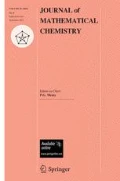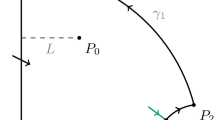Abstract
Schnakenberg model is a system showing sustained oscillations for a simple model of glycolysis in which a metabolic process that converts glucose to provide energy for metabolism. Euler approximation is implemented to obtain discrete version of Schnakenberg model. It is proved that discrete-time system via Euler approximation undergoes Neimark–Sacker bifurcation as well as period-doubling bifurcation is also examined at its unique positive steady-state. Keeping in view the dynamical consistency for continuous models, a nonstandard finite difference scheme is proposed for Schnakenberg model. It is proved that continuous system undergoes Hopf bifurcation at its interior equilibrium, whereas discrete-time system via nonstandard finite difference scheme undergoes Neimark–Sacker bifurcation at its interior fixed point. Some chaos and bifurcation control methods are implemented to both discrete-time models. Numerical simulation is provided to strengthen our theoretical discussion.













Similar content being viewed by others
References
I.R. Epstein, K. Showalter, Nonlinear chemical dynamics: oscillations, patterns, and chaos. J. Phys. Chem. 100(31), 13132–13147 (1996)
A. d’Onofrio, Uniqueness and global attractivity of glycolytic oscillations suggested by Selkov’s model. J. Math. Chem. 48, 339–346 (2010)
J. Schnakenberg, Simple chemical reaction systems with limit cycle behavior. J. Theor. Biol. 81, 389–400 (1979)
I. Prigogine, R. Lefever, Symmetry breaking instabilities in dissipative systems. II. J. Chem. Phys. 48, 1695–1700 (1968)
D.L. Benson, J.A. Sherratt, P.K. Maini, Diffusion driven instability in an inhomogeneous domain. Bull. Math. Biol. 55(2), 365–384 (1993)
L.J. Shaw, J.D. Murray, Analysis of a model for complex skin patterns. SIAM J. Appl. Math. 50, 628–648 (1990)
KS Al Noufaey, Semi-analytical solutions of the Schnakenberg model of a reaction-diffusion cell with feedback. Results Phys. 9, 609–614 (2018)
M. Sattari, J. Tuomela, On the numerical simulation of Schnakenberg model on evolving surface. Math. Sci. Lett. 4(3), 223–234 (2015)
A. Al-Zarka, A. Alagha, S. Timoshin, Transient behaviour in RDA systems of the Schnakenberg type. J. Math. Chem. 53, 111–127 (2015)
F. Yi, E.A. Gaffney, S. Seirin-Lee, The bifurcation analysis of turing pattern formation induced by delay and diffusion in the Schnakenberg system. Discrete Contin. Dyn. Syst. Ser. B 22(2), 647–668 (2017)
G. Liu, Y. Wang, Pattern formation of a coupled two-cell Schnakenberg model. Discrete Continuous Dyn. Syst. Ser. S 10(5), 1051–1062 (2017)
P. Liu, J. Shi, Y. Wang, X. Feng, Bifurcations analysis of reaction-diffusion Schnakenberg model. J. Math. Chem. 51, 2001–2019 (2013)
J. Zhu, Y.T. Zhang, S.A. Newman, M. Alber, Application of discontinuous Galerkin methods for reaction-diffusion systems in developmental biology. J. Sci. Comput. 40, 391–418 (2009)
Y. Ishii, K. Kurata, Existence and stability of one-peak symmetric stationary solutions for the Schnakenberg model with heterogeneity. Discrete Contin. Dyn. Syst. Ser. S 39(5), 2807–2875 (2019)
H. Qian, S. Saffarian, E.L. Elson, Concentration fluctuations in a mesoscopic oscillating chemical reaction system. Proc. Natl. Acad. Sci. 99(16), 10376–10381 (2002)
M. VelleLa, H. Qian, On the Poincaré-Hill cycle map of rotational random walk: locating the stochastic limit cycle in a reversible Schnakenberg model. Proc. R. Soc. A 466, 771–788 (2010)
J.D. Murray, Mathematical biology, 2nd edn. (Springer, New York, 1991), pp. 140–166
A. Goldbeter, Biochemical oscillations and cellular rhythms: the molecular bases of periodic and chaotic behaviour (Cambridge University Press, London, 1997)
D. Iron, J. Wei, M. Winter, Stability analysis of Turing patterns generated by the Schnakenberg model. J. Math. Biol. 49, 358–390 (2004)
Q. Din, A novel chaos control strategy for discrete-time Brusselator models. J. Math. Chem. 56(10), 3045–3075 (2018)
Q. Din, Bifurcation analysis and chaos control in discrete-time glycolysis models. J. Math. Chem. 56(3), 904–931 (2018)
Q. Din, T. Donchev, D. Kolev, Stability, bifurcation analysis and chaos control in chlorine dioxide-iodine-malonic acid reaction. MATCH Commun. Math. Comput. Chem. 79(3), 577–606 (2018)
Q. Din, M.A. Iqbal, Bifurcation analysis and chaos control for a discrete-time enzyme model. Z. Naturforschung A 74(1), 1–14 (2019)
P.C. Rech, Organization of the periodicity in the parameter-space of a glycolysis discrete–time mathematical model. J. Math. Chem. 57(2), 632–637 (2019)
P. Liu, S.N. Elaydi, Discrete competitive and cooperative models of Lotka–Volterra type. J. Comp. Anal. Appl. 3, 53–73 (2001)
R. Mickens, Nonstandard Finite Difference Methods of Differential Equations (World Scientific, Singapore, 1994)
J. Carr, Application of Center Manifold Theory (Springer, New York, 1981)
J. Guckenheimer, P. Holmes, Nonlinear Oscillations, Dynamical Systems, and Bifurcations of Vector Fields (Springer, New York, 1983)
C. Robinson, Dynamical Systems: Stability, Symbolic Dynamics and Chaos (Boca Raton, New York, 1999)
S. Wiggins, Introduction to Applied Nonlinear Dynamical Systems and Chaos (Springer, New York, 2003)
Y.H. Wan, Computation of the stability condition for the Hopf bifurcation of diffeomorphism on R2. SIAM. J. Appl. Math. 34, 167–175 (1978)
Y.A. Kuznetsov, Elements of Applied Bifurcation Theory (Springer, New York, 1997)
E. Ott, C. Grebogi, J.A. Yorke, Controlling chaos. Phys. Rev. Lett. 64(11), 1196–1199 (1990)
F.J. Romeiras, C. Grebogi, E. Ott, W.P. Dayawansa, Controlling chaotic dynamical systems. Phys. D 58, 165–192 (1992)
X.S. Luo, G.R. Chen, B.H. Wang, J.Q. Fang, Hybrid control of period-doubling bifurcation and chaos in discrete nonlinear dynamical systems. Chaos Soliton Fract. 18(4), 775–783 (2003)
E. Schöll, H.G. Schuster, Handbook of chaos control (Wiley, Weinheim, 2007)
S. Lynch, Dynamical Systems with Applications Using Mathematica (Birkhäuser, Boston, 2007)
K. Ogata, Modern Control Engineering, 2nd edn. (Prentice-Hall, Englewood, 1997)
Q. Din, Complexity and chaos control in a discrete-time prey-predator model. Commun. Nonlinear Sci. Numer. Simul. 49, 113–134 (2017)
Q. Din, Controlling chaos in a discrete-time prey-predator model with Allee effects. Int. J. Dyn. Control 6(2), 858–872 (2018)
Q. Din, Stability, bifurcation analysis and chaos control for a predator-prey system. J. Vib. Control 25(3), 612–626 (2019)
Q. Din, Neimark–Sacker bifurcation and chaos control in Hassell–Varley model. J. Differ. Equ. Appl. 23(4), 741–762 (2017)
Q. Din, Ö.A. Gümüş, H. Khalil, Neimark–Sacker bifurcation and chaotic behaviour of a modified Host–Parasitoid model. Z. Naturforschung A 72(1), 25–37 (2017)
Q. Din, Qualitative analysis and chaos control in a density-dependent host-parasitoid system. Int. J. Dyn. Control 6(2), 778–798 (2018)
L.-G. Yuan, Q.-G. Yang, Bifurcation, invariant curve and hybrid control in a discrete-time predator-prey system. Appl. Math. Model. 39(8), 2345–2362 (2015)
Author information
Authors and Affiliations
Corresponding author
Additional information
Publisher's Note
Springer Nature remains neutral with regard to jurisdictional claims in published maps and institutional affiliations.
Rights and permissions
About this article
Cite this article
Din, Q., Haider, K. Discretization, bifurcation analysis and chaos control for Schnakenberg model. J Math Chem 58, 1615–1649 (2020). https://doi.org/10.1007/s10910-020-01154-x
Received:
Accepted:
Published:
Issue Date:
DOI: https://doi.org/10.1007/s10910-020-01154-x
Keywords
- Schnakenberg model
- Nonstandard finite difference scheme
- Stability
- Neimark–Sacker bifurcation
- Period-doubling bifurcation
- Chaos control




